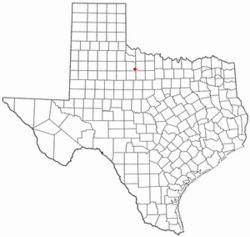Goree, Texas | |
|---|---|
 Location of Goree, Texas | |
 | |
| Coordinates: 33°28′7″N99°31′26″W / 33.46861°N 99.52389°W | |
| Country | United States |
| State | Texas |
| County | Knox |
| Area | |
• Total | 1.45 sq mi (3.75 km2) |
| • Land | 1.45 sq mi (3.75 km2) |
| • Water | 0.00 sq mi (0.00 km2) |
| Elevation | 1,453 ft (443 m) |
| Population (2020) | |
• Total | 158 |
| • Density | 110/sq mi (42/km2) |
| Time zone | UTC-6 (Central (CST)) |
| • Summer (DST) | UTC-5 (CDT) |
| ZIP code | 76363 |
| Area code | 940 |
| FIPS code | 48-30296 [2] |
| GNIS feature ID | 1358194 [3] |
| Census | Pop. | Note | %± |
|---|---|---|---|
| 1920 | 614 | — | |
| 1930 | 457 | −25.6% | |
| 1940 | 425 | −7.0% | |
| 1950 | 640 | 50.6% | |
| 1960 | 543 | −15.2% | |
| 1970 | 538 | −0.9% | |
| 1980 | 524 | −2.6% | |
| 1990 | 412 | −21.4% | |
| 2000 | 321 | −22.1% | |
| 2010 | 203 | −36.8% | |
| 2020 | 158 | −22.2% | |
| U.S. Decennial Census [4] | |||
Goree is a city in Knox County, Texas, United States. Its population was 158 at the 2020 census, [5] down from 203 at the 2010 census. [6]
